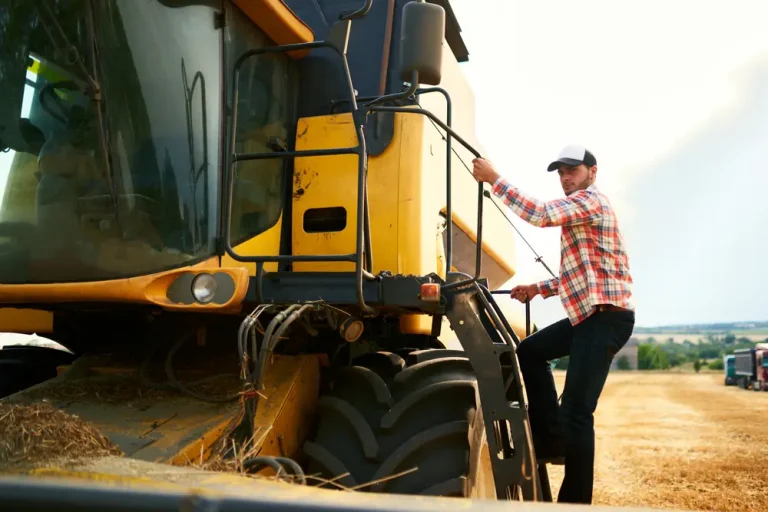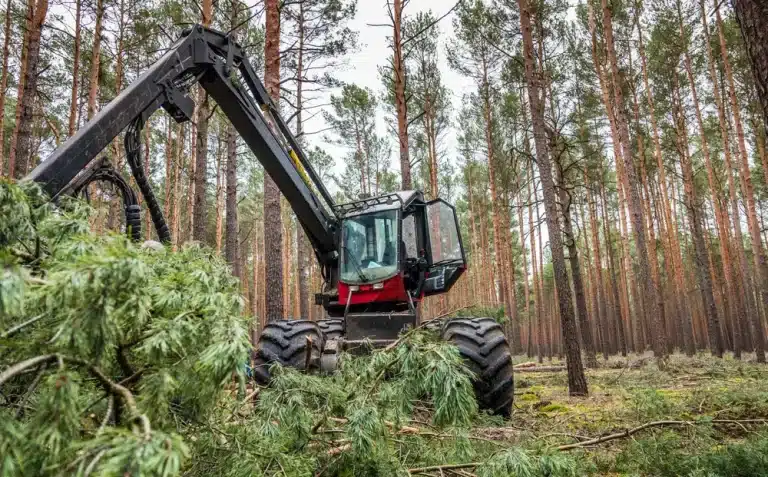Across forests, farmlands, and post-disaster sites, mulchers are becoming essential tools for professionals who prioritize sustainability without sacrificing productivity.
Their ability to clear, shred, and distribute vegetation in place makes them a powerful asset for restoring damaged soil, maintaining healthy plant diversity, and reducing the spread of wildfires.
From steep hillsides to flat agricultural zones, operators use mulchers to align efficiency with ecological care.
Mulchers support environmental goals by processing vegetation efficiently, preserving soil integrity, and encouraging ecological balance.
Their long-term value depends on the strategies chosen during setup, operation, and maintenance, as well as on informed decisions that align each project with sustainable land management principles.
Supporting ecological balance through targeted vegetation control
Modern mulching methods are no longer centered around aggressive land clearing. Instead, they are based on a more nuanced understanding of the landscape and its ecosystems.
Rather than stripping large areas of all vegetation, mulchers allow operators to process biomass selectively. This means only what is necessary is shredded and redistributed into the soil, leaving surrounding plant life untouched.
The result is a process that stabilizes the land, protects native ground cover, and promotes healthier long-term regrowth.
Such an approach contributes directly to ecological balance by maintaining the natural cycles that many species depend on.
Integrating this technique into broader land management strategies also improves site resilience. When paired with informed planning and adapted equipment, it can transform restoration zones into spaces that thrive independently over time.
From steep slopes to riparian areas, the ability to operate with precision makes mulchers a trusted ally for operators aiming to respect both terrain and biodiversity.
Encouraging native vegetation and habitat restoration
Land severely impacted by overgrowth, construction, or human activity often requires more than just cleanup. It needs regeneration. Mulchers serve this purpose not only by removing dense brush but by doing so in a way that favors the return of native plant species. By reducing invasive coverage and leaving nutrient-rich mulch behind, these machines create space for indigenous flora to reclaim the soil. Over time, this encourages biodiversity and strengthens ecosystems, leading to the natural return of animal habitats and improved soil structure.
Numerous field applications confirm that projects prioritizing native plant restoration see greater long-term stability. This is particularly valuable for landowners and public agencies managing protected areas or wildland-urban interfaces. Whether deployed in fire-affected zones or neglected parcels, mulchers help reestablish ecological harmony without disturbing the deeper layers of soil.
“Habitat restoration starts with how you clear, not just what you remove. Precision leaves room for nature to grow back stronger.”
When used correctly, these tools preserve the integrity of the land rather than reshaping it completely, making them essential in sustainable rehabilitation projects.
Limiting invasive species without chemical use

One of the most compelling environmental benefits of mulchers lies in their capacity to reduce invasive species without relying on herbicides. In many regions, chemical treatments are standard practice, but they often have downstream consequences, including soil degradation, contamination of nearby water sources, and harm to non-target plants. Mechanical mulching offers a cleaner alternative. By crushing invasive plants at root level and exposing them to natural decomposition, operators can weaken regrowth and avoid recurring infestations.
This method is particularly effective when integrated into routine equipment maintenance strategies. Keeping cutting tools sharp and machinery calibrated ensures efficient cutting and limits the risk of spreading seeds during operation. The result is a safer, more environmentally conscious way of managing vegetation.
Key benefits of chemical-free invasive control include:
- Preservation of neighboring crops and native plants
- Prevention of water pollution from runoff
- Alignment with land use and conservation regulations
- Long-term cost savings through reduced chemical dependency
Operators managing environmentally sensitive zones or adhering to stricter guidelines will find this method especially relevant. For more specialized operations, comparing mulcher types such as skid steer and spider excavator attachments can help identify the best fit for high-precision clearing.
How mulchers protect ecosystems from invasive plant diseases
Uncontrolled vegetation is not only a challenge to clear, it is often a source of hidden threats.
Dense, unmanaged plant growth creates a moist and shaded environment that favors the spread of fungal spores, bacterial colonies, and parasitic infestations.
These conditions become breeding grounds for diseases that affect not just the plants themselves, but the entire ecosystem. As infected plants die and decompose on-site, they spread pathogens to surrounding vegetation, reducing biodiversity and weakening the natural resilience of the land.
Mulchers help interrupt these cycles by systematically removing diseased or compromised growth before it contaminates healthy zones. This is particularly important in post-disaster cleanups or abandoned areas, where the accumulation of decaying biomass can fuel long-term outbreaks.
By grinding infected material into fine mulch, the spread of spores is minimized, and the pathogen’s life cycle is disrupted. In some cases, the mulch layer itself can suppress future fungal development by regulating ground temperature and moisture. This dual action, removal and suppression, makes mulchers uniquely valuable for preventive disease control in natural environments.
“Healthy ecosystems begin with clean, balanced vegetation. When you eliminate the sources of infection, you restore the strength of the entire landscape.”
To maximize the impact of this disease-prevention role, operators must ensure their machines are properly maintained. A mulcher with dull blades or clogged airflow systems can spread plant material unevenly or fail to grind infected parts thoroughly, undermining the process.
Key practices that strengthen disease control include:
- Regular inspection of vegetation for signs of infection before clearing
- Thorough mulching of all affected plant matter to prevent regrowth
- Sanitizing equipment between jobs to avoid cross-contamination
- Choosing the right machine setup based on site sensitivity
In operations where sustainable land use is a core objective, the ability to clear while simultaneously protecting plant health represents a long-term ecological advantage. When combined with well-defined services and tailored mulching strategies, this approach supports both environmental integrity and operational efficiency.
Reducing soil degradation and erosion on vulnerable terrain
Preserving topsoil and maintaining ground cover are essential steps in sustainable land care. Mulchers provide a unique advantage here, as they process vegetation into mulch that stays on-site, reinforcing the land’s protective layers.
Maintaining topsoil with ground-cover mulching
Instead of stripping the soil bare, mulchers leave a layer of shredded vegetation that acts as a protective blanket. This mulch traps moisture, regulates temperature, and gradually decomposes into nutrients.
Long-term benefits of ground-cover mulching:
- Reduces soil erosion after heavy rains
- Improves soil structure and fertility
- Supports water retention during dry periods
- Lowers the need for artificial irrigation
This process is especially effective when applied using skid steer machines configured with the right attachments.
Minimizing disturbance on steep or soft slopes
Traditional clearing techniques can damage fragile terrain, especially on steep gradients. Spider excavator mulchers are designed for those conditions, maintaining balance and reach while minimizing ground pressure. Their adaptive movement helps maintain root structures and reduce sliding soil.
Supporting natural water retention
Well-managed mulching prevents runoff by increasing the soil’s capacity to absorb water. This not only supports agricultural cycles but also benefits reforestation and land restoration projects.
“When you care for the land, the land returns the favor.”
Improving operational efficiency with sustainability in mind
Sustainability in land management does not require sacrificing operational speed or quality. On the contrary, it means adopting smarter approaches that combine the right machinery, diligent maintenance, and skilled teams working with the environment rather than against it.
Efficiency and sustainability become complementary goals when equipment is carefully selected, regularly serviced, and operated with an awareness of environmental impact.
This integrated mindset helps reduce waste, lowers fuel consumption, and minimizes soil disruption, all while maintaining high productivity. Adopting sustainable methods ensures that projects deliver lasting results without compromising future land health, a balance explored further throughout our services overview.
Matching equipment to terrain and vegetation
Operational efficiency starts with choosing the appropriate mulching machine tailored to the unique demands of the site.
- When working on flat, accessible terrain, skid steer mulchers offer maneuverability and speed.
- However, when the terrain is uneven, steep, or environmentally sensitive, spider excavator mulchers provide superior stability and precision.
These machines navigate difficult ground with minimal disturbance, making them ideal for areas requiring selective mulching or where preserving native flora is critical.
Key factors to match machine and environment:
- Terrain slope and soil type
- Vegetation density and height
- Required precision for selective mulching
- Environmental regulations in place
Enhancing productivity through consistent maintenance

The performance and sustainability of mulching equipment are deeply linked to how well it is maintained.
- Regular upkeep extends machine lifespan, improves operational efficiency, and reduces the environmental footprint.
- Keeping blades sharp ensures cleaner cuts, reducing unnecessary strain on the machine and the soil.
- Well-tuned hydraulics optimize power use and reduce fuel consumption,
- Prompt replacement of worn or damaged parts prevents breakdowns that cause delays and environmental hazards.
Maintenance not only supports operational goals but also aligns with responsible land management practices, as detailed in how to maintain your forestry mulcher for long-term performance, a resource that will guide you on extending machine life while minimizing ecological impact.
Training operators for sustainable practices
The role of the operator is crucial in translating sustainable intentions into concrete results. Skilled operators understand the importance of adjusting their technique based on the site conditions and project goals.
- Proper training focuses on maintaining safe mulching speeds to avoid unnecessary soil disruption and selecting optimal cutting depths that protect root systems and promote regrowth.
- Controlled navigation paths help limit soil compaction, preserving ground structure and preventing erosion.
- Sustainable operator habits also include avoiding over-mulching in sensitive areas to protect local biodiversity.
Investing in operator training improves safety, enhances productivity, and reduces the environmental footprint of mulching activities.
For more practical advice on safe operation, consult the page on Safety tips when operating a mulcher in tough terrain.
Did you know? A single hour of mulching on sloped terrain with a spider excavator can replace up to four hours of manual labor, while leaving 90 percent of the root structure intact.
Aligning mulching with environmental regulations and land goals
Modern land management is evolving. As environmental concerns grow and regulations become more stringent, landowners and contractors face increasing pressure to align their operations with sustainable practices. Mulchers are playing a crucial role in this shift. These powerful machines enable efficient vegetation control that not only respects ecological boundaries but also advances restoration and conservation goals. Whether working in protected areas, reducing wildfire threats, or contributing to long-term rehabilitation, mulchers serve as a practical solution that meets both legal requirements and environmental expectations.
By integrating mulching practices into broader environmental strategies, landowners and stewards can ensure they’re complying with laws while promoting biodiversity and soil health. This alignment of economic and environmental interests transforms mulching from a maintenance task into a meaningful tool for responsible land care.
Meeting legal requirements in sensitive zones
Protected environments, such as wetlands, wildlife corridors, and fire-prone zones, are governed by complex legal frameworks that restrict invasive machinery and disruptive practices. Here, precision is everything.
Mulchers, particularly when mounted on spider excavators, offer a high degree of control, making them suitable for use in these sensitive areas. Operators can maneuver over uneven terrain and around delicate ecosystems with minimal ground pressure, avoiding damage to native roots or nesting sites. With specialized attachments, like flail or disc mulchers, operators can tailor their approach to match the terrain and environmental demands.
Using the correct mulcher attachment is vital. For instance, in riparian zones or under tree canopies, selective mulching ensures only invasive or hazardous plants are removed. This strategic removal helps preserve the natural balance while satisfying regulatory requirements.
Reducing fire hazards through strategic clearing
In many parts of the world, fire seasons are longer, hotter, and more destructive than ever before. Fuel management has become a key strategy in wildfire prevention, and mulchers are essential to this effort.
By breaking down dense vegetation into fine mulch, these machines create natural firebreaks. Unlike traditional clearing methods that leave behind flammable debris, mulchers leave low-profile biomass that’s less likely to ignite. This reduces the intensity and spread of potential fires, especially in the wildland-urban interface where human settlements meet forested areas.
Municipalities, forest services, and private landowners are increasingly adopting mulching as a core part of fire prevention. Clearing underbrush, trimming tree limbs, and maintaining defensible spaces around properties are not only wise practices—they are often required by local fire ordinances.
Read how mulchers help reduce wildfire risks in dry zones for practical case studies and best practices.
Supporting long-term land restoration projects
Land restoration is a long game. Whether recovering from agricultural overuse, deforestation, or invasive species, successful ecological restoration depends on minimizing further soil disturbance. Mulchers are uniquely suited for this task.
Instead of turning the soil over or ripping through root systems, mulchers shred vegetation on the surface, returning organic matter to the ground. This protects vital mycorrhizal networks and microbial life, which are essential for soil regeneration. It also helps retain moisture and stabilize the soil structure, speeding up the recovery process.
Mulching is especially beneficial in reforestation projects, prairie rehabilitation, and erosion control. By reducing weed pressure and allowing native plants to reclaim the land naturally, mulchers become key allies in sustainable land care. Their ability to work quickly and precisely allows for large-scale restoration with a light ecological footprint.
How to plan your next sustainable mulching project
Whether you’re managing a fire-prone property, restoring a delicate ecosystem, or seeking to improve soil health, planning a sustainable mulching project starts with aligning tools, techniques, and long-term land goals.
Mulchers, when chosen and operated correctly, offer unmatched versatility and eco-conscious performance. Their ability to control vegetation without the harsh impacts of traditional land clearing methods makes them a cornerstone of modern, responsible land management.
From large-scale forestry operations to smaller conservation plots, sustainability doesn’t have to mean sacrificing efficiency. In fact, using mulchers is one of the most effective ways to reduce emissions, minimize soil disruption, and protect native flora and fauna—all while achieving your desired outcomes faster.
Here’s what you need to consider as you prepare your next mulching project:
- Define Your Primary Goal: Fire mitigation, invasive species control, habitat restoration, and erosion prevention each demand a slightly different mulching strategy.
- Select the Right Equipment: Not all mulchers are created equal. Choose a model and attachment suited for your terrain, vegetation type, and ecological sensitivity.
- Hire Skilled Operators: An experienced operator understands how to minimize environmental impact while maximizing efficiency and safety.
- Ensure Regulatory Compliance: Always align with local, state, or federal environmental regulations to avoid setbacks or penalties.
- Plan for Post-Mulching Maintenance: Follow-up strategies, such as reseeding native plants or applying erosion controls, can amplify the positive outcomes of your mulching work.
By prioritizing sustainability and thoughtful planning, your mulching project can deliver long-term environmental and economic benefits. It’s more than just land clearing, it’s land stewardship.
Ready to get started?
Let us help you plan a mulching project that aligns perfectly with your land management goals and sustainability vision.
Whether you’re focused on fire mitigation, habitat restoration, or soil preservation, our team is here to guide you from strategy to execution.



